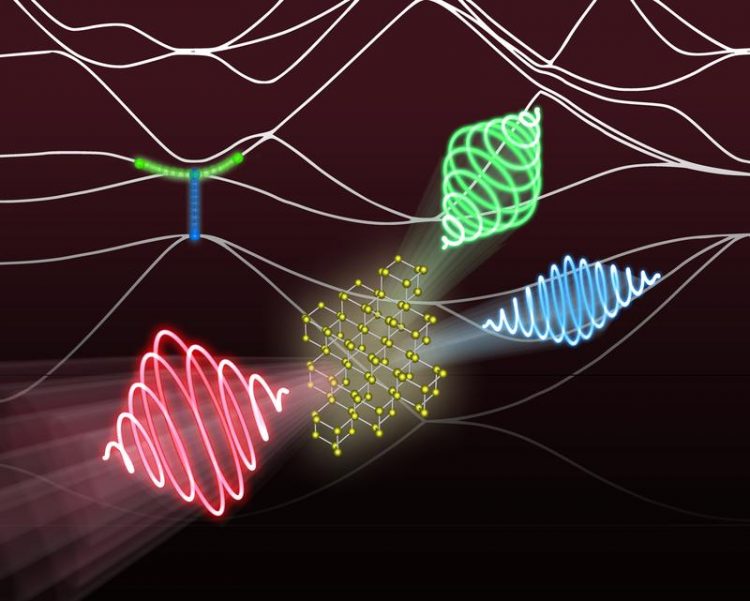A new knob to control and create higher harmonics in solids

When exciting crystals such as silicon by an intense elliptically or circularly polarized light pulse (red), circularly polarized higher harmonics (green & blue) can be generated. Nicolas Tancogne-Dejean + Joerg M. Harms, MPSD
The generation of high-order harmonics in gases is nowadays routinely used in many different areas of sciences, ranging from physics, to chemistry and biology. This strong-field phenomenon consists in converting many low-energy photons coming from a very strong laser, to fewer photons with a higher energy. Despite the growing interest in this phenomenon in solids, the mechanism behind the conversion of light is still under debate for solid materials.
Scientists from the MPSD (Max Planck Institute for the Structure and Dynamics of Matter) and CFEL* (Center for Free-Electron Laser Science) in Hamburg used state-of-the-art theoretical simulation tools to advance the fundamental understanding of this phenomenon in solids. Their work is published in Nature Communications.
When atoms and molecules interact with strong laser pulses, they emit high-order harmonics of the fundamental driving laser field. The high-harmonic generation (HHG) in gases is regularly used nowadays to produce isolated attosecond pulses and coherent radiation ranging from visible to soft x-rays. Because of a higher electronic density, solids are one promising route towards compact, brighter HHG sources. However, their use is currently hampered by the lack of a microscopic understanding of the mechanism leading to HHG from solids.
Researchers at the MPSD and CFEL have now shown that, by using elliptically polarized driving light, it is possible to unravel the complex interplay between the two mechanisms responsible for HHG in solids. By means of extensive first-principles simulations they have shown how these two mechanisms are strongly and differently affected by the ellipticity of the driving laser field.
The complex interplay between these effects can be used to tune and improve harmonic emission in solids. In particular, they have shown that the maximal obtained photon energy can be increased by as much as 30% using a finite ellipticity of the driving laser field.
They also demonstrated the possibility of generating circularly polarized harmonics with alternating helicity from a single circularly polarized driving field, thus opening a new avenue for a better understanding and control of HHG in solids based on ellipticity, with intriguing new opportunities in the spectroscopy of magnetic materials. Their work shows that ellipticity provides an additional knob to experimentally control high-order harmonic generation in solids.
*CFEL is a scientific collaboration of DESY, Max-Planck-Gesellschaft and Universität Hamburg
Original publication:
Ellipticity dependence of high-harmonic generation in solids: unraveling the interplay between intraband and interband dynamics
N. Tancogne-Dejean, O.D. Mücke, F.X. Kärtner, A. Rubio
Nature Communications, s41467-017-00764-5 (2017)
For further information please contact Jenny Witt, Presse- und Öffentlichkeitsarbeit MPSD, +49 40 8998 6593 / jenny.witt@mpsd.mpg.de
http://dx.doi.org/10.1038/s41467-017-00764-5 Original publication
Media Contact
More Information:
http://www.mpsd.mpg.deAll latest news from the category: Physics and Astronomy
This area deals with the fundamental laws and building blocks of nature and how they interact, the properties and the behavior of matter, and research into space and time and their structures.
innovations-report provides in-depth reports and articles on subjects such as astrophysics, laser technologies, nuclear, quantum, particle and solid-state physics, nanotechnologies, planetary research and findings (Mars, Venus) and developments related to the Hubble Telescope.
Newest articles

Can lab-grown neurons exhibit plasticity?
“Neurons that fire together, wire together” describes the neural plasticity seen in human brains, but neurons grown in a dish don’t seem to follow these rules. Neurons that are cultured…

Unlocking the journey of gold through magmatic fluids
By studying sulphur in magmatic fluids at extreme pressures and temperatures, a UNIGE team is revolutionising our understanding of gold transport and ore deposit formation. When one tectonic plate sinks…

3D concrete printing method that captures carbon dioxide
Scientists at Nanyang Technological University, Singapore (NTU Singapore) have developed a 3D concrete printing method that captures carbon, demonstrating a new pathway to reduce the environmental impact of the construction…



